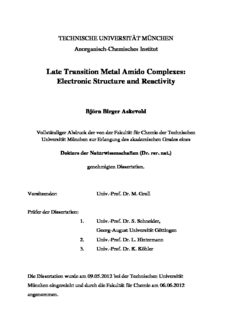
Late Transition Metal Amido Complexes PDF
Preview Late Transition Metal Amido Complexes
TECHNISCHE UNIVERSITÄT MÜNCHEN Anorganisch-Chemisches Institut Late Transition Metal Amido Complexes: Electronic Structure and Reactivity Björn Birger Askevold Vollständiger Abdruck der von der Fakultät für Chemie der Technischen Universität München zur Erlangung des akademischen Grades eines Doktors der Naturwissenschaften (Dr. rer. nat.) genehmigten Dissertation. Vorsitzender: Univ.-Prof. Dr. M. Groll Prüfer der Dissertation: 1. Univ.-Prof. Dr. S. Schneider, Georg-August Universität Göttingen 2. Univ.-Prof. Dr. L. Hintermann 3. Univ.-Prof. Dr. K. Köhler Die Dissertation wurde am 09.05.2012 bei der Technischen Universität München eingereicht und durch die Fakultät für Chemie am 06.06.2012 angenommen. To my family. Thanks for all the support, for having placed your trust in me and especially for all the love I received, always and whitout any question. This thesis originated in the time between January 2009 and April 2012 at the Anorganisch- Chemisches Institut of Technische Universität München and the Friedrich-Alexander- Universität Erlangen-Nürnberg. I am deeply indebted to my mentor Professor Dr. Sven Schneider Thank you for this fascinating topic, your absolute trust in my skills, for the interest which you had in my work and for all these invaluable scientific discussions, which were crucial for the success of this thesis. I also want to express my gratitude to Professor Dr. Dr. h. c. mult. Wolfgang A. Herrmann and Professor Dr. Karsten Meyer Thank you very much for the possibility to work in your chair, for the excellent infrastructure which I was allowed to use and for all the support which I was granted. This thesis was supported by a scholarship of the the international doctorate program NanoCat and the TUM graduate school. Furthermore, my very special thanks go to: Prof. Dr. Jörg Eppinger and his group members at the TU München Dr. Thomas Reiner, Dr. Alice Schlichtiger, Dr. Stefan Faul, Dr. Alexander Nicandro Marziale and Dominik Jantke for several stimulating scientific and non-scientific discussions. I specifically want to thank my colleagues in the Schneider group Dr. Anja Friedrich, Dr. Jorge Torres Nieto, Jenni Meiners and Markus Scheibel for a wonderful time in the lab and beyond. Furthermore, Markus Scheibel for the help with this work. Dr. Eberhardt Herdtweck and Frank Heineman (X-ray diffraction) for their tireless efforts and many instructive discussions. Special thanks go to the members of the microanalytical lab Mrs. Ulrike Ammari and Mr. Thomas Tafelmaier for their continuous efforts in enabling the measurement of highly air sensitive samples. I would further like to acknowledge the administrative staff, particularly Mrs. Irmgard Grötsch, for her dedication. Further acknowledgements are made to the external collaborators of the Schneider group, Prof. Dr. Holthausen (Frankfurt), Prof. Dr. Filippou (Bonn) and Dr. M. Khusniyarov (Friedrich-Alexander Universität Erlangen-Nürnberg). I would also like to thank the many other researchers from the Department Chemie in Munich and in Erlangen. Most of you have become friends over the years. Sebastian Hock, Daniel Betz, Lars-Arne Schaper, Stefan Reindl and Ingrid Span for the exciting and amazing time we spent together during our undergraduate studies. Thank you for staying friends over the years. Last but not least: all my friends, who always supported me and understood if there is still an interesting experiment to do. Abbreviations Å angstrom ACN acetonitrile BDE bond dissociation energy br broad Calcd. calculated CO carbon monoxide COE cylcooctene CV cyclic voltammetry DCM dichloromethane DFT density functional theory DMSO dimethylsulfoxide d doublet dd doublet of doublet δ chemical shift (ppm) Eq. equation equiv. equivalent FT-IR fourier transform infrared spectroscopy G Gibbs energy (J mol-1) H molar enthalpy (J mol-1) Hz hertz HETCOR heteronuclear correlation, NMR spectroscopic method HMQC heteronuclear multiple quantum coherence, NMR spectroscopic method h hour(s) iPr isopropyl J coupling constant (Hz) K equilibrium constant k rate constant KIE kinetic isotope effect L ligand M molar (mol L-1) Me methyl MHz megahertz m multiplet (NMR), medium (IR) min minute(s) mL milliliter(s) μ micro NMR nuclear magnetic resonance ν wave number (cm-1) OTf- trifluoromethanfulfonate PMe trimethylphosphine 3 Ph phenyl PPh triphenylphosphine 3 ppm parts per million q quarted R alkyl or aryl r reaction constant r.d.s rate determining step r.t. room temperature S entropy (J mol-1K-1) s second(s); singlet (NMR); strong (IR) sp septet THF tetrahydrofurane TOF turnover frequency TON turnover number t triplet tBu tertiary butyl vt virtual triplet X halide Table of Contents A Introduction 11 1 Late transition metal amido complexes: metal-ligand bonding and reactivity 12 2 Late transition metal amido complexes: relevance for catalysis and MLC 16 3 Goal and motivation 19 B Results and discussion 21 1 Reactivity of iridium(I) PNP amido complex towards protonation and oxidation 22 1.1 Introduction 23 1.2 Results and discussion 25 1.3 Conclusion 30 1.4 Experimental section 30 1.5 Cyclic voltammetry 33 1.6 Computational methods 34 2 A square-planar ruthenium(II) complex with low-spin configuration 38 2.1 Introduction 39 2.2 Results and discussion 40 2.3 Conclusion 45 2.4 Synthetic and analytical details 46 2.5 Single crystal X-ray diffraction 48 2.6 Spectroscopic results 49 2.7 Computational results 56 3 Square-planar ruthenium(II) PNP pincer complexes: control of electronic structure by tuning of NM -donation 64 3.1 Introduction 65 3.2 Results and discussion 69 3.3 Conclusions 78 3.4 Synthetic and analytical details 79 3.5 Spectroscopic results 82 3.6 Computational results 87 4 Ammonia formation by metal-ligand cooperative hydrogenolysis of a nitrido ligand 89 4.1 Abstract 90 4.2 Introduction 90 4.3 Results and discussion 92 4.4 Conclusions 99 4.5 Synthetic and analytical details 101 4.6 Crystallographic details 107 4.7 Computational examinations 109 5 Learning from the neighbours: improving homogeneous catalysts with functional ligands motivated by heterogeneous and bio-catalysis 124 5.1 Introduction 125 5.2 Inspiration from heterogeneous catalysis: homogeneous polymerization catalysts with lewis acidic co-ligands 126 5.3 Bio-inspired homogeneous catalysis: metal-ligand cooperating (MLC) catalysis 130 5.4 Concluding remarks 155 C Summary 157 D Zusammenfassung 165 E List of publication 173 1 Journal publications 174 1 Presentations 174 F Curriculum Vitae 175
Description: